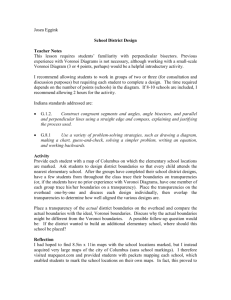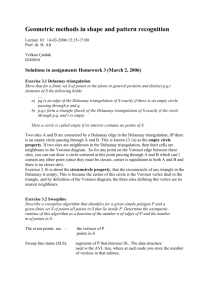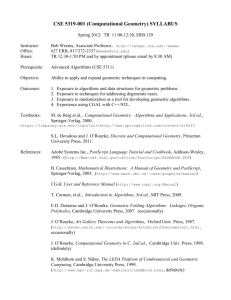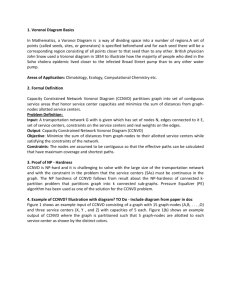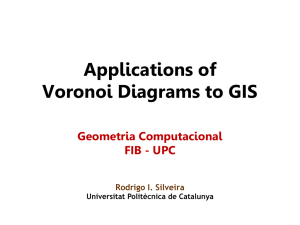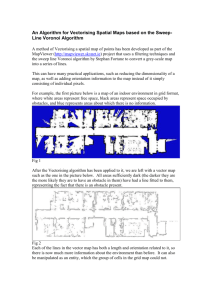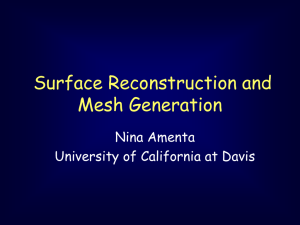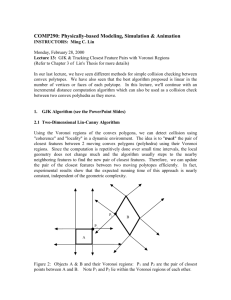Design and Analysis of Algorithms
advertisement
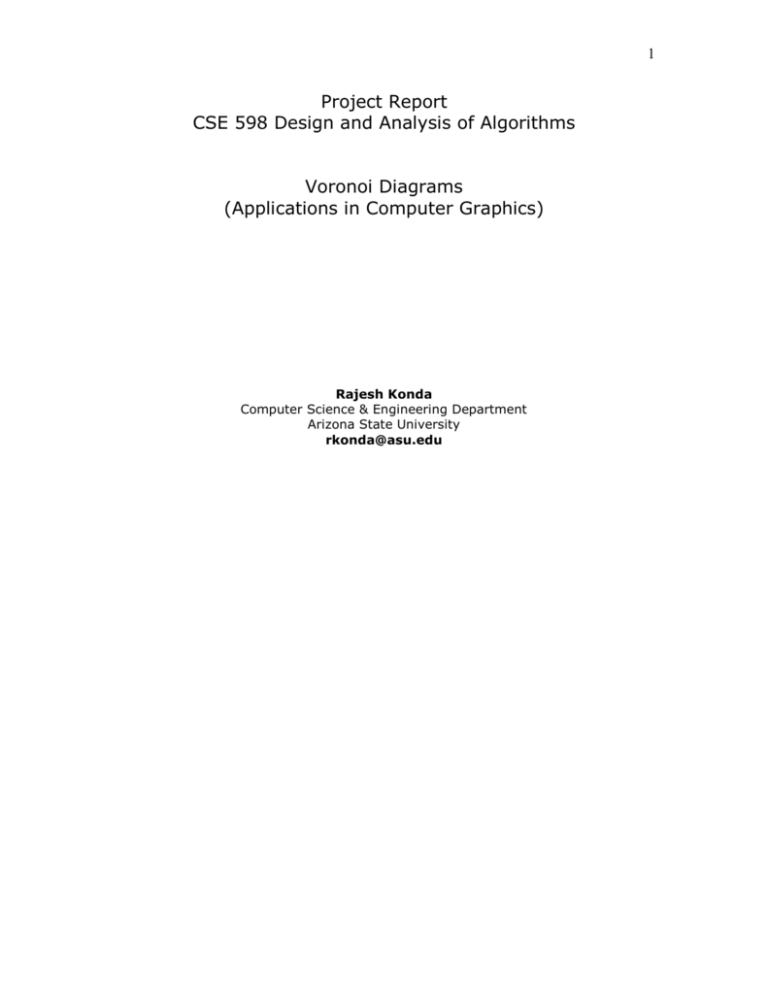
1
Project Report
CSE 598 Design and Analysis of Algorithms
Voronoi Diagrams
(Applications in Computer Graphics)
Rajesh Konda
Computer Science & Engineering Department
Arizona State University
rkonda@asu.edu
2
INDEX
1
2
Introduction .......................................................................................... 3
Definitions ............................................................................................. 3
2.1
Constructing a Voronoi Diagram ..................................................... 4
3
Applications ........................................................................................... 5
3.1
Applications in Computer Graphics ................................................. 7
3.1.1
Constrained Delaunay triangulations and triangulations of
polygons ................................................................................................ 7
3.1.2
Steiner triangulations of parameter domains ........................... 8
3.1.3
Voronoi diagrams ..................................................................... 9
3.1.4
Visualization of crystal structures using Voronoi diagrams .... 10
4
Properties of Voronoi Diagrams ........................................................... 11
4.1
Complexity Properties ................................................................... 13
5
Properties of Delaunay triangulations ................................................. 15
6
complexity of Algorithms FOR constructing Voronoi Diagrams and
Delaunay Triangulations ............................................................................ 16
7
Examples of Applications of Voronoi Diagrams .................................... 16
7.1
Computational Geometry .............................................................. 16
7.2
Applications in Computer Graphics ............................................... 18
7.2.1
Sibson’s Interpolant ............................................................... 18
7.2.2
Terrain Modeling .................................................................... 19
7.2.2.1 Voronoi diagrams can be used to generate perspective
images of slab models ...................................................................... 19
7.2.2.2 Terrain Modeling for Virtual Battlefields (Project by ACMD) 20
8
Terrain Modeling using Voronoi Hierarchies ........................................ 21
8.1
Introduction ................................................................................. 21
8.2
Adaptive Clustering Approach ....................................................... 22
8.3
Constructing Voronoi Hierarchies ................................................. 24
8.4
The Algorithm ............................................................................... 25
8.5
Numerical Results ......................................................................... 26
9
SUMMARY ............................................................................................ 28
10
References: ...................................................................................... 29
3
1
INTRODUCTION
In this project I have attempted to study the properties of Voronoi Diagrams and its
dual Delaunay Triangulations, and their uses in different fields and particularly
Computational Geometry and Computer Graphics. Voronoi Diagrams are one of the
most popular Data Structures in Computational Geometry and find extensive
applications in all fields of science and engineering. They are particularly very useful
in surface reconstruction and terrain simplification algorithms. Voronoi Diagrams
make a very interesting study not only because of their applicability in complex
problems but also in real life simple problems.
In this report I have made an attempt to give the definition and properties of Voronoi
Diagrams and Delaunay Triangulations. I have mentioned some important
applications of them. There are several useful illustrations that help you understand
the concept. I have also described one algorithm for Terrain Modeling that uses
Voronoi-based Adaptive Clustering Techniques.
I have provided extensive reference for the material. The readers are encouraged to
refer to them for more information and illustrations. I hope you will find this material
simple and useful.
2
DEFINITIONS
A Voronoi diagram of a set of "sites" (points) on a plane is a collection of regions that
divide up the plane. Each region corresponds to one of the sites, and all the points in
one region are closer to the corresponding site than to any other site.
Fig. 2.1 Voronoi Diagrams separate the plane of sites into regions
All of the Voronoi regions are convex polygons. Some of them are infinite -- these
correspond to the sites on the convex hull. The boundary between two adjacent
4
regions is a line segment, and the line that contains it is the perpendicular bisector of
the segment joining the two sites. Usually, Voronoi regions meet three at a time at
Voronoi points. If three sites determine Voronoi regions that meet at a Voronoi point,
the circle through those three sites is centered at that Voronoi point, and there are
no other sites in the circle.
Fig. 2.2 Two points
Fig. 2.3 Voronoi Diagram of two points
2.1 Constructing a Voronoi Diagram
Fig. 1 shows two points. Fig. 2 shows the Voronoi Diagram. It is a perpendicular
bisector of the line segment joining the two points. It extends to infinity on both
sides.
Half planes
5
A Voronoi vertex is the center of an empty circle touching 3 or more sites.
Fig. 2.1.1
Voronoi Diagram given 3 sites.
Voronoi diagram is sometimes also known as a Dirichlet tessellation. The cells are
called Dirichlet regions, Thiessen polytopes, or Voronoi polygons.
Fig 2.4 Voronoi Diagrams and Delaunay Triangulations
The Delaunay triangulation and Voronoi diagram in
graph theoretical sense.
are dual to each other in the
To build the Delaunay triangulation, draw a line segment between any two sites
whose Voronoi regions share an edge. This procedure splits the convex hull of the
sites into triangles.
3
APPLICATIONS
The Voronoi Diagram and its geometric dual, the Delaunay Triangulation, have
proved to be two of the most important data structures in Computational Geometry.
The Voronoi Diagram and its variants (different metrics, higher dimensions, sites
which are segments or polygons instead of points, etc.) have been rediscovered
many times in several fields including, but not limited to, anthropology, archeology,
astronomy,
biology,
cartography,
chemistry,
computational
geometry,
crystallography, ecology, forestry, geography, geology, linguistics, marketing,
metallography, meteorology, operations research, physics, physiology, remote
sensing, statistics, and urban and regional planning.
A book-length survey of the types of Voronoi Diagrams and their applications in a
variety of fields was written by Okabe, Boots, and Sugihara [11].
The following is a list of applications of Voronoi Diagrams in about twenty different
fields, though often not referred by the same name
6
Anthropology and Archeology -- Identify the parts of a region under the
influence of different neolithic clans, chiefdoms, ceremonial centers, or hill
forts.
Astronomy -- Identify clusters of stars and clusters of galaxies (Here we saw
what may be the earliest picture of a Voronoi diagram, drawn by Descartes in
1644, where the regions described the regions of gravitational influence of the
sun and other stars.)
Biology, Ecology, Forestry -- Model and analyze plant competition ("Area
potentially available to a tree", "Plant polygons")
Cartography -- Piece together satellite photographs into large "mosaic"
maps
Crystallography and Chemistry -- Study chemical properties of metallic
sodium ("Wigner-Seitz regions"); Modeling alloy structures as sphere
packings ("Domain of an atom")
Finite Element Analysis -- Generating finite element meshes which avoid
small angles
Geography -- Analyzing patterns of urban settlements
Geology -- Estimation of ore reserves in a deposit using information obtained
from bore holes; modeling crack patterns in basalt due to contraction on
cooling
Geometric Modeling -- Finding "good" triangulations of 3D surfaces
Marketing -- Model market of US metropolitan areas; market area extending
down to individual retail stores
Mathematics -- Study of positive definite quadratic forms ("Dirichlet
tessellation", "Voronoi diagram")
Metallurgy -- Modeling "grain growth" in metal films
Meteorology -- Estimate regional rainfall averages, given data at discrete
rain gauges ("Thiessen polygons")
Pattern Recognition -- Find simple descriptors for shapes that extract 1D
characterizations from 2D shapes ("Medial axis" or "skeleton" of a contour)
Physiology -- Analysis of capillary distribution in cross-sections of muscle
tissue to compute oxygen transport ("Capillary domains")
Robotics -- Path planning in the presence of obstacles
Statistics and Data Analysis -- Analyze statistical clustering ("Natural
neighbors" interpolation)
Zoology -- Model and analyze the territories of animals
In addition to all these "real world" applications, Voronoi diagrams have several
applications within the field of computer science, in particular, computational
geometry.
Knuth's Post Office Problem -- Given a set of locations for post offices,
how do you determine the closest post office to a given house? (Apparently,
Knuth was ignoring the existence of ZIP codes.)
Closest Pair -- Given a set of points, which two are closest together?
All Nearest Neighbors -- Given a set of points, find each point's nearest
neighbor
Euclidean Minimum Spanning Tree
Largest Empty Circle, also known as the Toxic Waste Dump Problem
Fixed Radius Near Neighbors -- Find all pairs of points closer than a given
distance apart.
All k Nearest Neighbors -- Find each point's k closest neighbors
7
Enumerating interpoint distances in increasing order -- Find the closest
pair, then the next closest pair, then the next closest pair, and so on.
A quick search through recent computational geometry literature finds about 300
papers, almost all published in the last decade, with either "Voronoi" or "Delaunay"
in the title. Over a third of those papers were published since 1990.
3.1 Applications in Computer Graphics
Some applications of Voronoi Diagrams in Computer Graphics are listed below
3.1.1 Constrained Delaunay triangulations and triangulations of polygons
Constrained Delaunay triangulations and triangulations of polygons are necessary for
mesh generation of plane parameter domains of trimmed surfaces .
Fig 3.1.1.1
Right: Constrained Delaunay triangulation.
Left: Delaunay triangulation of polygons
8
Fig 3.1.1.2 Adaptive net network of trimmed parameterized surfaces
3.1.2 Steiner triangulations of parameter domains
Steiner triangulations in two dimensions are necessary for the visualization of
trimmed surfaces as well as for Finite Element meshing.
Fig 3.1.2.1
Right: Delaunay triangulation of a polygonal domain
Left: Steiner triangulation of the domain with given maximal edge length
9
3.1.3 Voronoi diagrams
Fig 3.1.3.1
Delaunay triangulation and Voronoi diagram of a point set of 100 points
10
3.1.4 Visualization of crystal structures using Voronoi diagrams
Fig 3.1.4.1 Visualization of crystal structures using Voronoi diagrams
11
4
PROPERTIES OF VORONOI DIAGRAMS
Property 1. A point q lies on a Voronoi edge between sites pi and pj iff the largest
empty circle centered at q touches only pi and pj
– A Voronoi edge is a subset of locus of points equidistant from pi and pj
pi : site points
e : Voronoi edge
v : Voronoi vertex
Property 2 A point q is a vertex iff the largest empty circle centered at q touches at
least 3 sites
– A Voronoi vertex is an intersection of 3 more segments, each equidistant from a
pair of sites
pi : site points
e : Voronoi edge
v : Voronoi vertex
12
Property 3 For a Voronoi diagram generated by a set of distinct points P = {p 1, … ,
pn} R2 (2 ≤ n < ), a Voronoi polygon V(pi) is unbounded if and only if pi is on the
boundary of the convex hull of P, i.e. pi CH(P).
Property 4 For the Voronoi diagram generated by a set of distinct points P = { p 1, …
, pn} (2 ≤ n < ):
(i)
Voronoi edges are infinite straight lines if and only if P is collinear.
(ii)
A Voronoi edge e(pi, pj) (≠ ∅) is a half line if and only if P is non-collinear
and pi and pj are consecutive generator points of the boundary of CH(P).
(iii)
Suppose that pi and pj give a Voronoi edge e( pi, pj). Then the edge is a
finite line segment if and only if the line segment p ipj is not an edge of
CH(P).
Property 5 The nearest generator point of pi generates a Voronoi edge of V(pi).
Property 6 The nearest generator point from pi exists in the generator points whose
Voronoi polygons share the Voronoi edges of V(pi).
This property is useful in solving the following well-known problems:
Problem 1 The Closest Pair Problem
For a finite set P of distinct points, if the distance between pi P and pj P is the
minimum among the distances between all possible pairs of points in P, we say that
the pair {pi, pj} is the closest pair. Given P, find the closest pair.
Problem 2 The all nearest neighbor problem
Given a finite set P of distinct points, find the nearest neighbor point of pi for every
pi P.
Property 6 suggests that when we want to solve the above problems, we need not
compare all distances from pi with the rest of the generator points; we just compare
the distances from pi with the generator points whose Voronoi polygons share the
Voronoi edges of V(pi). Once problem 2 is solved with the comparison, it is easy to
find reciprocal pairs. A pair {pi, pj} is a reciprocal (nearest) pair when pi is the
nearest neighbor point of pj, and pj is the nearest neighbor point of pi. The closest
pair is found in the reciprocal pairs.
Property 7 The generator pi is the nearest generator point p if and only if V(pi)
contains p.
Problem 3 The nearest-search problem
Given a finite set of distinct points, find the nearest neighbor point among P from a
given point p (p is not necessarily a point in P).
This problem is often referred to as the post office problem (Knuth, 1973). This can
be solved efficiently using a Voronoi diagram.
Property 8 The average number of Voronoi edges per Voronoi polygon does not
exceed six.
13
4.1 Complexity Properties
1) Voronoi diagrams have linear complexity {|v|, |e| = O(n)}
a) Intuition: Not all bisectors are Voronoi edges!
pi : site points
e : Voronoi edge
b) Claim: For n ≥ 3, |v| ≤ 2n - 5 and |e| ≤ 3n - 6
Proof: (Easy Case)
For collinear sites |v| = 0, |e| = n – 1
c) Claim: For n ≥ 3, |v| ≤ 2n - 5 and |e| ≤ 3n - 6
Proof: (General Case)
•Euler’s Formula: for connected, planar graphs,
|v| – |e| + f = 2
Where:
|v| is the number of vertices
|e| is the number of edges
f is the number of faces
14
d) Claim: For n ≥ 3, |v| ≤ 2n - 5 and |e| ≤ 3n - 6
Proof: (General Case)
•For Voronoi graphs, f = n which means that (|v| +1) – |e| + n = 2
To apply Euler’s Formula, we
“planarize” the Voronoi diagram
by connecting half lines to
an extra vertex.
Moreover,
and
v Vor (P),
deg( v) 3
so
together with
(| v | 1) | e | n 2
we get, for n ³ 3
| v | 2n 5
| e | 3n 6
15
5
PROPERTIES OF DELAUNAY TRIANGULATIONS
Property 1 The external Delaunay edges in D(P) constitute the boundary of the
convex hull of P.
Property 2 All circumcircles of Delaunay triangles are empty circles.
This can be restated as below:
Three points pi, pj, pk P are vertices of the same face
of the DG(P) iff the circle through pi, pj, pk contains no
point of P on its interior.
Property 3 Two points pi, pj Î P form an edge of DG(P) iff
there is a closed disc C that contains pi and pj on its
boundary and does not contain any other point of P.
16
6
COMPLEXITY OF ALGORITHMS FOR CONSTRUCTING
VORONOI DIAGRAMS AND DELAUNAY TRIANGULATIONS
1) Voronoi Diagrams
Half Plane intersection Algorithm. The complexity is O(n2 log n)
Fortune’s Algorithm – Sweep Line Algorithm. The complexity is O(n log n)
2) Delaunay Triangulation
7
Randomized Incremental Method. The complexity is O(n log n)
EXAMPLES OF APPLICATIONS OF VORONOI DIAGRAMS
7.1 Computational Geometry
a) Nearest Neighbors
We have seen this problem when we discussed the properties of Voronoi diagrams.
b) Triangulation Maximizing the Minimum Angle
Analyzing the structural properties of complex shapes is often accomplished by a
technique called “finite element analysis”. This is used, for example, by automobile
manufacturers to model car bodies. The domain to be studied is partitioned into
“finite elements”, and then the relevant differential equations modeling the structural
dynamics are solved by discretizing over the partition. The stability of the numerical
procedures used depends on the quality of the partition, and Delaunay triangulations
are especially good partitions.
A triangulation of a point set S is the generalization of the object of which Delaunay
Triangulation is a particular instance: a set of segments whose endpoints are in S,
which only intersect each other at endpoints, and which partition the convex hull of S
into triangles. For the purposes of finite element analysis, triangulations of fat
triangles are best. One way to make this more precise is to avoid triangles with small
angles. Thus, it is natural to seek a triangulation that has the largest smallest angle,
that is, to maximize the smallest angle over all the triangulations. This happens to be
precisely the Delaunay Triangulation.
A Delaunay Triangulation is the angle optimal triangulation
c) Largest Empty Circle
Find the largest empty circle whose center is in the (closed) convex hull of a set of n
sites S, empty in that it contains no sites in its interior, and largest in that there is no
other such circle with strictly larger radius.
Such a circle is a good location for a new store. Another application is to locate a
nuclear reactor as far away from a collection of city-sites as possible.
The following property of Voronoi Diagram is useful for solving this problem:
If the center p of a largest empty circle is strictly interior to the hull of sites, then p
must be coincident with a Voronoi vertex.
17
If the center p of a largest empty circle lies on the hull of sites, then p must lie on a
Voronoi edge.
d) Minimum Spanning Tree
A minimum spanning tree (MST) of a set of points is a minimum length tree that
spans all the points: a shortest tree whose nodes are precisely those in the set.
When the length of an edge is measured by the usual Euclidean length of the
segment connecting its endpoints, the tree is often called the Euclidean minimum
spanning tree (EMST).
The MST is a subset of the Delaunay Triangulation
Kruskal’s minimum spanning tree algorithm is a greedy algorithm. Its complexity is
dominated by the first sorting step. This requires O(E log E) time, where E is the
number of edges in the graph.
For the MST of points in the plane, there are nC2 edges, so the complexity of the
sorting step is O(n2 log n) if carries out on the complete graph.
We can improve the Kruskal’s algorithm by first finding the Delaunay Triangulation
in O(n log n) time, and then sort only those O(n) edges, in O(n log n) time. The
remainder of Kruskal’s algorithm can be implemented to run in O(n log n), so that
the total complexity for finding the MST for a set of n points in the plane is O(n log
n).
e) Traveling Salesperson Problem
One of the most-studies problems in computer science is the Traveling Salesperson
problem: find the closest path that visits every point in a given set. Such a path is
called a traveling salesperson path (TSP): imagine the points as cites that the
salesperson must visit in arbitrary order before returning home. The problem has
tremendous practical significance, not only for the application, but because many
other problems can be reduced to it. The problem is NP-hard. The combination of
practical significance and intractability have lead to a search for effective heuristics
and approximation algorithms. One of the simplest approximation algorithms is
based on the Delaunay Triangulations, via the Minimum Spanning Tree.
The idea is to find the MST and follow that out and back. The tour constructed this
way has exactly twice the length of the MST, since each edge of the tree is traversed
once in each direction.
18
7.2 Applications in Computer Graphics
7.2.1 Sibson’s Interpolant
Sibson’s
i.
ii.
iii.
Interpolant provides a solution to the following problem:
A set of N scattered data points pn in the plane.
A function zn at each point.
Find: a reasonably smooth function f, defined over the convex hull of the
pn, which is an exact interpolant, such that f(pn) = zn for n = 1, …, N and
which reflects the shape of the input data.
Sibson’s approach is to compute the Voronoi diagram of the data points, and then
using an identity called the local coordinates property to construct a new interpolant.
The local coordinates property states that a point which is inserted within the convex
hull of the data points can be expressed as a convex combination of its neighboring
points’ positions and “contributing” tile areas. Specifically, a point p will have m
neighbors p1, …, pn after being inserted into the set of data points. Each neighbor
would contribute a portion of its own tile area to create p’s tile. Each of these areas
then will be a fraction ui of p’s total tile area, where
We can call u = (u1, … , um) the local or Sibson coordinates of p, where
is the local coordinates property.
The following is an example of a point being inserted into a Voronoi diagram. The
inserted point there has five neighbors (m = 5) which each donate a part of their
own tile area to form the new point’s tile. If we associate a function value zn with
each data site pn, we can interpolate a value at any point p within the convex hull of
the pn. This can be accomplished by determining p’s Sibson coordinates u, the
function values of p’s neighbors, and using Sibson’s interpolant
19
Fig 7.2.1.1 Voronoi Diagram
Fig 7.2.1.2 Insertion of a Voronoi
point in the Voronio Diagram
7.2.2 Terrain Modeling
7.2.2.1 Voronoi diagrams can be used to generate perspective images of
slab models
Indonesian subduction zone. The adjacent figure below consists of 2164 nodes
and 5372 tetrahedra. The tetrahedra outside of the slab have been removed from
this view.
You can refer to this site
http://rses.anu.edu.au/seismology/projects/RUM/slabs/slabs.html
20
7.2.2.2 Terrain Modeling for Virtual Battlefields (Project by ACMD)
The project involves developing and testing computational-geometric algorithms
pertinent to the implementation of Triangulated Irregular Networks (TINs) enabling
distributed terrain simulation for military training and orientation. At issue here is
data-reduction and value-adding while maintaining realistic but parsimonious
representation of terrain. The project is supported by ARPA.
21
8
TERRAIN MODELING USING VORONOI HIERARCHIES
We will now look at an algorithm for Terrain Modeling using a Voronoi-based
Adaptive Clustering Method. This method uses Sibson’s Interpolant and Voronoi
diagrams. Starting with a set of scattered data sites in the plane with associated
function values defining a height field, the algorithm constructs a top-down hierarchy
of smooth approximations. The convex hull of the given sites will be used as the
domain for the hierarchical representation. Sibson’s interpolant is used to
approximate the underlying height field based on associated function values of
selected subsets of the data sites. The algorithm constructs a hierarchy of Voronoi
diagrams for nested subsets of the given sites. The quality of approximations
obtained with this method compares favorably to results obtained from other
multiresolution algorithms like wavelet transforms. The approximations for every
level of resolution are C1 continuous, except at the selected sites, where only C 0
continuity is satisfied. The expected time complexity of the algorithm is O(n log n)
for n sites when applying simple acceleration methods. In addition to a hierarchy of
smooth approximations, this method provides a cluster hierarchy based on convex
cells and an importance ranking for sites.
8.1 Introduction
Clustering techniques [7] generate a data-dependent partitioning of space
representing inherent topological and geometric structures of scattered data.
Adaptive clustering methods recursively refine this partitioning resulting in a
multiresolution representation that is required for applications like progressive
transmission, compression, view-dependent rendering, and topology reconstruction.
For example, topological structures of two-manifold surfaces can be reconstructed
from scattered points in three-dimensional space using Adaptive Clustering Methods
[6]. In contrast to mesh-simplification algorithms, Adaptive Clustering Methods do
not require a grid structure connecting the given data points. A cluster hierarchy is
built in a “top-down” approach, so that coarse levels of resolution require less
computation times than finer levels. Arbitrary samples taken from large-scale terrain
models are recursively selected according to their relevance.
Continuous approximations of the terrain model are constructed based on the
individual sets of selected sites using Sibson’s interpolant [10]. We have
implemented this algorithm using a Delaunay triangulation, i.e., the dual of a
Voronoi diagram, as underlying data structure. Constructing a Delaunay triangulation
requires less implementation than constructing the corresponding Voronoi diagram,
since a lot of special cases (these where Voronoi vertices have a valence greater
than three) can be ignored. A major drawback of Delaunay triangulations is that they
are not unique, in general. This becomes evident when the selected sites are
sampled from regular, rectilinear grids such that the diagonal for every quadrilateral
can be flipped, resulting in random choices affecting the approximation. The
corresponding Voronoi diagram, however, is uniquely defined and can instantly be
derived from a Delaunay triangulation. Sibson’s interpolant is also efficiently
computed from a Delaunay triangulation.
22
Fig 8.1.1 Scattered points with associated function values.
The advantage of this method compared to Delaunay-based multiresolution methods
[5] is that the approximations obtained are unique and C1-continuous almost
everywhere.
8.2 Adaptive Clustering Approach
Adaptive clustering schemes construct a hierarchy of regions, each of which is
associated with a simplified representation for the data points located inside. We
assume that a data set is represented at its finest level of resolution by a set P of n
points in the plane with associated function values, t = 0, 1, …
This set P is sampled from a continuous function
where
is a
compact domain containing all points pi. The points pi define the associated
parameter values for the samples fi. There are no assumptions of any kind of
“connectivity” or grid structure for the points pi. For other applications than terrain
modeling, the points pi can have s dimensions with t-dimensional function values fi,
see Figure 1.
The output of an adaptive clustering scheme consists of a number of levels
defined as
where for every level with index j, the tiles (regions)
form a partitioning of the domain D, the functions
function values of points located in the tiles
and the residuals
approximate the
, i.e.,
estimate the approximation error. In principle, any
error norm can be chosen to compute the residuals
. The error norm has a high
23
impact on the efficiency and quality of the clustering algorithm, since it defines an
optimization criterion for the approximations at every level of resolution. The
following norm is suggested:
where
is the number of points located in tile
. In the case of p =
the residual is simply the maximal error within the corresponding tile.
A global error
with respect to this norm can efficiently be computed for every level
of resolution from the residuals
as
Starting with a coarse approximation
an adaptive clustering algorithm computes
finer levels
from
until a prescribed number of clusters or a prescribed error
bound is satisfied. To keep the clustering algorithm simple and efficient, the
approximation
should differ from
only in cluster regions with large residuals
in
. As the clustering is refined, it should eventually converge to a space
partitioning, where every tile contains exactly one data point or where the number of
points in every tile is sufficiently low providing zero residuals.
24
Fig 8.2.1 Planar Voronoi diagram and its dual, the (not uniquely
defined) Delaunay triangulation.
Fig 8.2.2 Construction of Delaunay triangulation by point insertion. Every
triangle whose circumscribed circle contains the inserted point is erased. The
points belonging to removed triangles
are connected to the new point
Fig 8.2.3 Computing Sibson’s interpolant at point p by inserting p into a Voronoi diagram and using
the areas cut away from every tile as blending weights.
8.3 Constructing Voronoi Hierarchies
The following is a description of the adaptive clustering approach for multiresolution
representation of scattered data: a hierarchy of Voronoi diagrams [2, 9] constructed
from nested subsets of the original set of points.
The Voronoi diagram of a set of points pi, i = 1, … , n in the plane is a space
partitioning consisting of n tiles Ti. Every tile Ti is defined as a subset of
25
containing all points that are closer to pi than to any pj with respect to the
Euclidean norm.
A Voronoi diagram can be derived from its dual, the Delaunay triangulation [1, 3, 4,
5], see Figure 2. The circumscribed circle of every triangle in a Delaunay
Triangulation does not contain any other data points. If more than three points are
located on such a circle, then the Delaunay triangulation is not unique. The Voronoi
vertices are located at the centers of circumscribed circles of Delaunay triangles,
which can be exploited for constructing a Voronoi Diagram. The Voronoi diagram is
unique, in contrast to the Delaunay triangulation.
A Delaunay triangulation is constructed in expected linear time, provided the points
are evenly distributed [8]. Figure 3 illustrates the adaptive construction process in
the plane. For every point inserted into a Delaunay triangulation, all triangles whose
circumscribed circles contain the new point are erased. The points belonging to the
erased triangles are then connected to the new point, defining new triangles that
automatically satisfy the Delaunay property.
Point insertion is an operation performed in expected constant time, provided that
the triangles to be removed are identified in expected constant time, which requires
the use of some acceleration method. For applications in k dimensional spaces (k <
2) the Delaunay triangulation consists of k-simplices whose circumscribed kdimensional hyperspheres contain no other point.
The adaptive clustering algorithm uses Sibson’s interpolant [10] constructing the
functions
Sibson’s interpolant is based on blending function values fi associated
with the points pi that define the Voronoi diagram. The blending weights for Sibson’s
interpolant at a point
are computed by inserting p temporarily into the
Voronoi diagram and by computing the areas ai that are “cut away” from Voronoi
tiles Ti, see Figure 4. The value of Sibson’s interpolant at p is defined as
Sibson’s interpolant is C1-continuous everywhere except at the points pi. To avoid
infinite areas ai, the Voronoi diagram is clipped against the boundary of the compact
domain D. A natural choice for the domain D is the convex hull of the points p i.
8.4 The Algorithm
(i) Construct the Voronoi diagram for the minimal point set defining the convex hull
of all points pi, i = 1, … , n. The tiles of this Voronoi diagram define the cluster
regions
of level L0.
(ii) From the functions
defined by Sibson’s interpolant and from error norm (1) (p
= 2) compute all residuals
To avoid square root computations
is stored.
26
(iii) Refinement:
Let m be the index of a maximal residual in Lj, i.e.,
Among all
maximal error
identify a data point
with
Insert pmax into the Voronoi diagram.
(iv) Update
and all residuals associated with tiles adjacent to the new tile
with center pmax (All other clusters remain unchanged, i.e.,
and
)
(v) Compute the global approximation error
using the error norm (2). Terminate
the process when a prescribed global error bound is satisfied or when a prescribed
number of points has been inserted. Otherwise, increment j and continue with step
(iii).
8.5 Numerical Results
The Voronoi-based clustering approach has been used to approximate the terrain
data set “Crater Lake”, courtesy of U.S. Geological Survey. This data set consists of
159272 samples at full resolution. Approximation results for multiple levels of
resolution are shown in Figure 5 and in Table 1. The quality of approximations
obtained with this method compares favorably to results obtained from other
multiresolution algorithms like wavelet transforms. A standard compression method,
for example, is the use of a wavelet transform followed by quantization and
arithmetic coding of the resulting coefficients. Using the Haar-wavelet transform for
compression of the Crater-Lake data set (re-sampled on a regular grid at
approximately the same resolution) results in approximation errors (p = 2) of 0.89
percent for a 1:10 compression and 4.01 percent for a 1:100 compression [2]. It is
noted that for a Voroni-based compression method also the locations of the samples
need to be encoded. In addition to a hierarchy of smooth approximations, this
method provides a cluster hierarchy based on convex cells and an importance
ranking for sites. Future work will be directed at the explicit representation of
discontinuities and sharp features.
27
Figure 5: Crater-Lake terrain data set at different levels of resolution.
28
9
SUMMARY
In this report we have see the definitions and properties of Voronoi Diagrams, their
use in different fields, in particular Computational Geometry and Computer Graphics.
We have seen one algorithm that uses Voronoi Diagrams and Sibson’s Interpolant for
Terrain Modeling.
We have seen excellent illustrations of Voronoi Diagrams and their properties and
also Visual description of their usage in Graphics.
Current research in Imagery using Voronoi Diagrams includes
Automatic simplification of geometric models by Michael J.Hollick:
This project addresses the need for a method of reducing the geometric
complexity of objects to achieve real time frame rates, while maintaining taskspecific details.
Clonal mosaic model by Marcelo Walter:
Modeling of animal patterns created by a clonal mosaic process directly on the
animal body.
Edge-based Image Segmentation
How to place a reaction-diffusion texture on a model.
Model based face reconstruction for animation
Real Face Communication in a Virtual World
Surface Reconstruction
Using Voronoi methods for the Reconstruction of images from labelled graphs
by M. Pötzsch.
The Crust Algorithm for 3D Surface Reconstruction from Scattered Points:
New algorithm for the reconstruction of surfaces of arbitrary topology from
unorganized sample points in 3D.
For a complete list of the applications of Voronoi Diagrams in different fields, please
look at this website:
http://www.voronoi.com/new_page_221211.htm
29
10 REFERENCES:
[1] M. de Berg, M. van Kreveld, M. Overmars, and O.Schwarzkopf, Computational Geometry: Algorithms
and Applications, Springer-Verlag, Berlin, Germany, 1997.
[2] M. Bertram, Multiresolution Modeling for Scientific Visualization, Ph.D. Thesis, Department of
Computer Science, University of California at Davis, 2000.
http://graphics.cs.ucdavis.edu/ bertram
[3] G. Farin, Surfaces over Dirichlet tessellations, Computer Aided Geometric Design, Vol. 7, No. 1–4,
1990, pp 281–292.
[4] L. De Floriani, B. Falcidieno, and C. Pienovi, A Delaunay-based method for surface approximation,
Proceedings of Eurographics ’83, Amsterdam, Netherlands, 1983, pp. 333–350, 401.
[5] L. De Floriani and E. Puppo, Constrained Delaunay triangulation for multiresolution surface
description, Proceedings of Ninth IEEE International Conference on Pattern Recognition, IEEE, 1988,
pp. 566–569.
[6] B. Heckel, A.E. Uva, B. Hamann, and K.I. Joy, Surface reconstruction using adaptive clustering
methods, IEEE Transactions on Visualization and Computer Graphics, submitted, 2000.
[7] B.F.J. Manly, Multivariate Statistical Methods, A Primer, second edition, Chapman & Hall, New York,
1994.
[8] Maus, Delaunay triangulation and convex hull of n points in expected linear time, BIT, Vol. 24, No. 2,
pp. 151–163, 1984.
[9] S.E. Schussman, M. Bertram, B. Hamann and K.I. Joy, Hierarchical data representations based on
planar Voronoi diagrams, R. van Liere, I. Hermann, and W. Ribarsky, eds., Proceedings of VisSym ’00,
Joint Eurographics and IEEE TCVG Conference on Visualization, Amsterdam, Netherlands, May 2000.
[10]
[11]
70.
R. Sibson, locally equiangular triangulation. The Computer Journal, Vol. 21, No. 2, 1992, pp. 65–
Okabe, B. Boots, and K. Sugihara, Spatial Tesselations: Concepts and Applications of Voronoi
Diagrams, Wiley, 1992. ISBN 0 471 93430 5
[12]
http://mathworld.wolfram.com/VoronoiDiagram.html
World of Mathematics webpage on Voronoi Diagrams
[13]
http://www.ics.uci.edu/%7Eeppstein/gina/scot.drysdale.html#dna
Geometry in Action: Voronoi Diagrams: Applications from Archaology to Zoology
[14]
http://www.gris.uni-tuebingen.de/gris/proj/algo/algo_e.html
Computational Geometry in Computer Graphics
[15]
http://www.gris.uni-tuebingen.de/gris/proj/geomod/meshing.html
Adaptive net network of trimmed parameterized surfaces
[16]
http://nms.lcs.mit.edu/~aklmiu/6.838/L7.ppt
Voronoi Diagrams: Lecture by Allen Miu
[17]
http://www.voronoi.com/new_page_221211.htm
The Voronoi website
[18]
http://rses.anu.edu.au/seismology/projects/RUM/slabs/slabs.html
Perspective images of slab models
[19]
http://www-2.cs.cmu.edu/afs/cs/user/garland/www/multires/my-work.html
Info on Multiresolution Modeling
[20]
http://www-2.cs.cmu.edu/afs/cs/user/garland/www/scape/
Terrain Simplification
30
[21]
http://www-2.cs.cmu.edu/afs/cs/user/garland/www/multires/survey.html
Survey of Multiresolution Modeling

